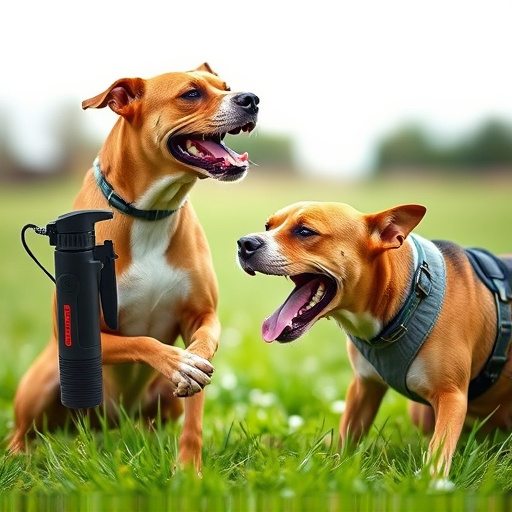Canine pepper spray, a tool for law enforcement and dog handlers, temporarily disables aggressive dogs without harm. Formulated with capsaicin, it irritates eyes and respiratory systems. Storage is crucial; keep in a locked cabinet, cool, dry location away from children and pets to maintain potency. When selecting or using dog repellent spray, prioritize safety, effectiveness, and proper application techniques while adhering to legal guidelines and maintaining optimal storage conditions.
“Unleashing the power of pepper spray in canine law enforcement has emerged as a game-changer. This comprehensive guide explores the effective use of police-grade dog repellent spray, delving into its composition and potency. We’ll navigate the market to uncover the best store options for this powerful tool, ensuring optimal results through safe application techniques. Additionally, legal considerations and ethical implications will be discussed, providing a thorough understanding of this innovative law enforcement method.”
- Understanding Canine Pepper Spray: Composition and Effectiveness
- Choosing the Best Dog Repellent Spray for Police-Grade Quality
- Safe Use and Application Techniques for Optimal Results
- Legal Considerations and Ethical Use of Canine Pepper Spray
Understanding Canine Pepper Spray: Composition and Effectiveness
Canine pepper spray, also known as dog repellent spray, is a specialized law enforcement tool designed to temporarily disable or deter aggressive dogs. Unlike traditional pepper spray formulated for humans, canine versions are tailored to be effective against animal senses while ensuring safety for users. This spray typically contains capsaicin, the same compound found in chili peppers, which irritates a dog’s eyes and respiratory system when inhaled.
When used correctly, it provides an efficient and non-lethal means of controlling problematic dogs. The key to its effectiveness lies in the precise composition and application method. It’s important to store this spray in a secure, cool place, out of reach from pets and children, as it is potent and needs to be handled with care. Using the best way to store dog repellent spray—in a dedicated, locked cabinet—ensures its integrity for when you need it most.
Choosing the Best Dog Repellent Spray for Police-Grade Quality
When it comes to selecting a dog repellent spray that matches police-grade quality, understanding your specific needs is paramount. Look for products formulated specifically for professional use, designed to be potent yet safe and effective against aggressive dogs. Active ingredients like capsaicin or black pepper oil are key; they trigger discomfort in dogs’ eyes and respiratory system, encouraging them to retreat.
The best way to store a dog repellent spray is in a secure location out of reach of both children and pets. Keep it cool and dry, and ensure the container remains sealed to maintain potency. Always follow safety guidelines strictly when handling any spray, including wearing protective gear if necessary. Regularly inspect the product for signs of damage or expiration to ensure its continued effectiveness.
Safe Use and Application Techniques for Optimal Results
When using canine pepper spray, or dog repellent spray, it’s crucial to understand safe application techniques for optimal results and minimal risk. The best way to store and deploy this product is by following strict safety protocols. Always keep it out of reach of children and pets, in a secure location that is not easily accessible. Prior to use, ensure the area is well-ventilated to avoid inhalation irritations. When applying, use quick, short bursts at the base of the animal’s neck or hind legs, aiming away from the face. This targeted approach minimizes impact on non-target species and bystanders while effectively deterring canines.
For optimal effectiveness, consider environmental factors. Pepper spray works best in open spaces where wind can disperse the spray evenly. Avoid using it in strong winds or dense vegetation where the spray might not reach the intended target. Regularly test the spray’s potency and expiration date to ensure its continued effectiveness. Store it in a cool, dry place, following manufacturer guidelines for optimal preservation. By adhering to these safe use and storage practices, you can maximize the efficacy of canine pepper spray while minimizing potential hazards.
Legal Considerations and Ethical Use of Canine Pepper Spray
The use of canine pepper spray, also known as dog repellent spray, is a controversial topic that raises important legal and ethical considerations. While it can be an effective tool for police and security personnel to control and subdue aggressive dogs, its application must adhere to strict guidelines to ensure public safety and animal welfare. The legality of using pepper spray on dogs varies by jurisdiction, with some regions allowing its use only in specific circumstances, such as when a dog poses an imminent threat to human life or is seriously injuring someone.
When it comes to the best way to store dog repellent spray, proper handling and storage practices are crucial for safety and efficacy. It is essential to keep these sprays out of reach of children and pets, in secure containers that meet regulatory standards. Additionally, training and protocols should be in place for law enforcement officers to ensure they use pepper spray ethically, only when necessary, and with the least amount required to effectively control a situation without causing unnecessary harm to the animal or bystanders.
When it comes to selecting a canine pepper spray, choosing police-grade quality is essential for both effectiveness and legal compliance. By understanding its composition, safe application techniques, and legal considerations, you can ensure the best way to store and use dog repellent spray while prioritizing safety and responsible usage. Remember, the right product, coupled with proper knowledge, can be a powerful tool in effective canine deterrence.
